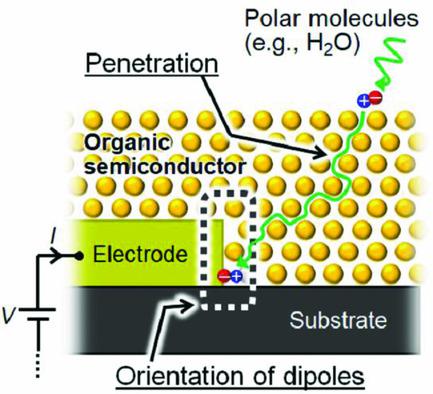当前位置:
X-MOL 学术
›
Adv. Mater. Interfaces
›
论文详情
Our official English website, www.x-mol.net, welcomes your feedback! (Note: you will need to create a separate account there.)
Dipolar Switching of Charge‐Injection Barriers at Electrode/Semiconductor Interfaces as a Mechanism for Water‐Induced Instabilities of Organic Devices
Advanced Materials Interfaces ( IF 5.4 ) Pub Date : 2018-10-08 , DOI: 10.1002/admi.201801261 Ryo Nouchi 1, 2
Advanced Materials Interfaces ( IF 5.4 ) Pub Date : 2018-10-08 , DOI: 10.1002/admi.201801261 Ryo Nouchi 1, 2
Affiliation

|
An electrode contact–related mechanism for the operational instability of organic electronic devices is proposed and confirmed via observation of a water‐induced change in charge‐injection barrier heights at the electrode/organic‐semiconductor interfaces. Water molecules in air penetrate into the organic crystal via diffusion, and an external electric field orients the electric dipole of the water molecules at the electrode surfaces, leading to dipolar switching of the charge‐injection barrier height. As a result of the switching, current–voltage curves of two‐terminal Au–rubrene–Au devices change from symmetric to asymmetric, showing diode‐like rectification and reversible switching of the diode polarity. The device shows the highest current switching ratio of 267 for the switching voltage of 3 V, corresponding to an electrode work function change of >144 meV. The mechanism proposed herein will be important especially for short‐channel organic devices, which are indispensable for applications such as organic integrated circuits.
中文翻译:

电极/半导体界面上电荷注入势垒的双极转换是有机器件水致不稳定性的一种机制
提出了一种与电极接触有关的有机电子设备操作不稳定性的机制,并通过观察水在电极/有机半导体界面处电荷注入势垒高度的水诱导变化来确定这种机制。空气中的水分子通过扩散渗透到有机晶体中,外部电场使水分子的电偶极子在电极表面定向,从而导致电荷注入势垒高度的偶极转换。切换的结果是,两端Au-rubrene-Au器件的电流-电压曲线从对称变为不对称,显示出类似二极管的整流和二极管极性的可逆切换。对于3 V的开关电压,该器件显示出最高的电流开关比267,对应的电极功函数变化> 144 meV。本文提出的机制对于短通道有机器件尤其重要,这对于有机集成电路等应用是必不可少的。
更新日期:2018-10-08
中文翻译:

电极/半导体界面上电荷注入势垒的双极转换是有机器件水致不稳定性的一种机制
提出了一种与电极接触有关的有机电子设备操作不稳定性的机制,并通过观察水在电极/有机半导体界面处电荷注入势垒高度的水诱导变化来确定这种机制。空气中的水分子通过扩散渗透到有机晶体中,外部电场使水分子的电偶极子在电极表面定向,从而导致电荷注入势垒高度的偶极转换。切换的结果是,两端Au-rubrene-Au器件的电流-电压曲线从对称变为不对称,显示出类似二极管的整流和二极管极性的可逆切换。对于3 V的开关电压,该器件显示出最高的电流开关比267,对应的电极功函数变化> 144 meV。本文提出的机制对于短通道有机器件尤其重要,这对于有机集成电路等应用是必不可少的。



























 京公网安备 11010802027423号
京公网安备 11010802027423号